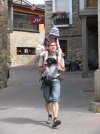These might be too long, but my favorite stretch might be:
Begin at Hospital de Órbigo Km 275. B&B Puente de Órbigo. Highly recommend this B&B: 3 private bedrooms, nice owner. Read about the old bridge (PUENTE DE ÓRBIGO (PASSO HONROSO)) and walk across it to have dinner in the old town.
TO:
Astorga, Km 257, Day 1. Here you will take first notice of the Maragato culture, the ancient tribe of red-headed Iberians that served as the muleteers between the coast and the interior of Spain. They maintain several curious customs by modern standards, doing most thing the exact opposite as we are accustomed. One of these is their cocido, a meal which is served meat first and greens last. Three buildings of note: 1. The Ayuntamiento (whose animatronic sculptures ring in the hours), 2. The Palacio Episcopal, which was never occupied by the Bishop and which was designed by Gaudi, and 3. the Catedral de Astorga. The last two can be visited on a joint ticket for 5 euros but the opening hours are not always clear. There is also a good Roman museum and a Chocolate Museum. I literally stopped in my tracks when I came around a corner and saw the Gaudi palace and Cathedral.
Day 2: Astorga to Rabanal del Camino Km 239. Rabanal is a common (and wise) stopping point along the way. Ahead is a high mountain pass that demands a bit of rest. Vespers are sung by the monks every night at 7pm at the small parish Iglesia de Santa María and a benediction for pilgrims is held afterward.
Day 3, Rabanal del Camino to Molinaseca Km 213:
Cruz de Ferro Km 229: The Iron Cross marks the highest part of the mountain pass and has become the place where pilgrims the world over leave behind a stone brought with them from home or elsewhere on the camino. Read a bit about this spot. Another famous photo-op.
Molinaseca, Beautiful town, river, bridge, and old churches, etc. Narrow old pedestrian “Main Street” lined with cafes and restaurants. But also spend a night in Ponferrada.
Day 4, Molinaseca to Ponferrada. Km 205. Ponferrada’s Templar castle is one of the best-preserved examples of its kind and offers a glimpse into what castle life must have been like in the 12th and 13th centuries. This place looks practically new, like Walt Disney just built it. The Iglesia de Santa María de la Encina is named for a Templar legend according to which her image was found in the trunk of an Oak tree. It is located in the oldest part of town, near the castle. Check out the Templar’s castle, and dinner in the Plaza de la Virgen del Encina. And maybe on your way into Ponferrada, the sweet little old lady will still be handing-out cake and welcoming/chatting with pilgrims.
Day 5, Ponferrada to Villafranca del Bierzo. Km 181. On the edge of Castilla y León, you’ll reach the town of Villafranca del Bierzo, one of the most important towns along the Camino in the region. Its grand monuments and elegant mansions down the Calle del Agua have earned it the heritage status of Property of Cultural Interest. San Francisco de Assisi passed through 800 years ago and is said to have founded the Iglesia de San Francisco, do pay it a visit as it often doubles as an exhibition hall (plus its elevation affords a good view as the sun sets in the valley). Definitely one of my favorite towns. Check out the garden, the Calle del Agua, and the Puente Medieval de Villafranca and pilgrim statue. There is a sidewalk café across the street from the garden, next to a playground and old church (Colegiata de Santa María de Cluni), with a view of the façade of the Iglesia de San Nicolás El Real being lit up and colored by the setting sun.

















